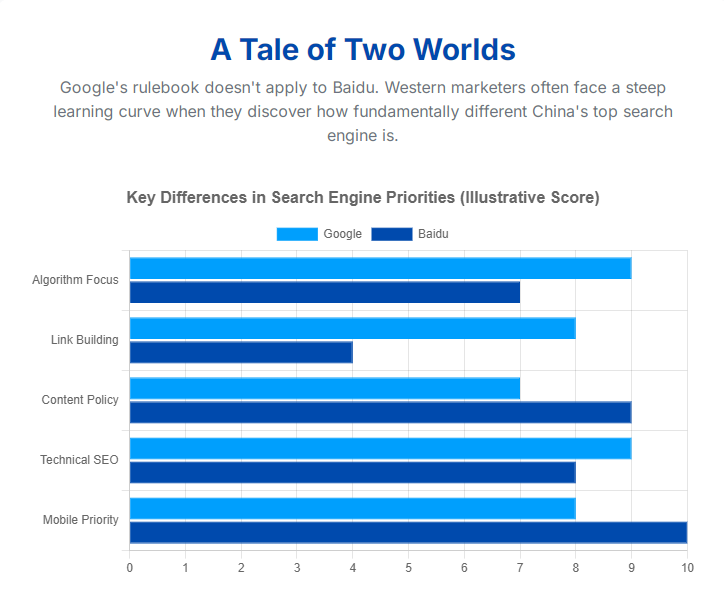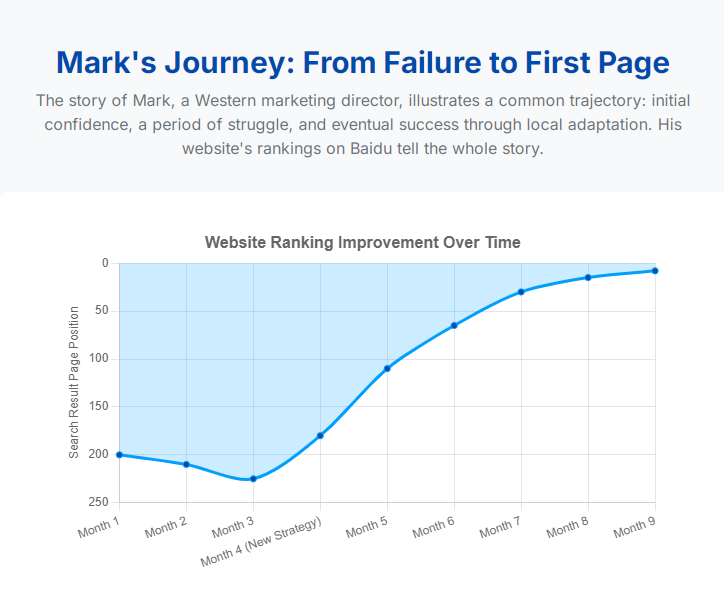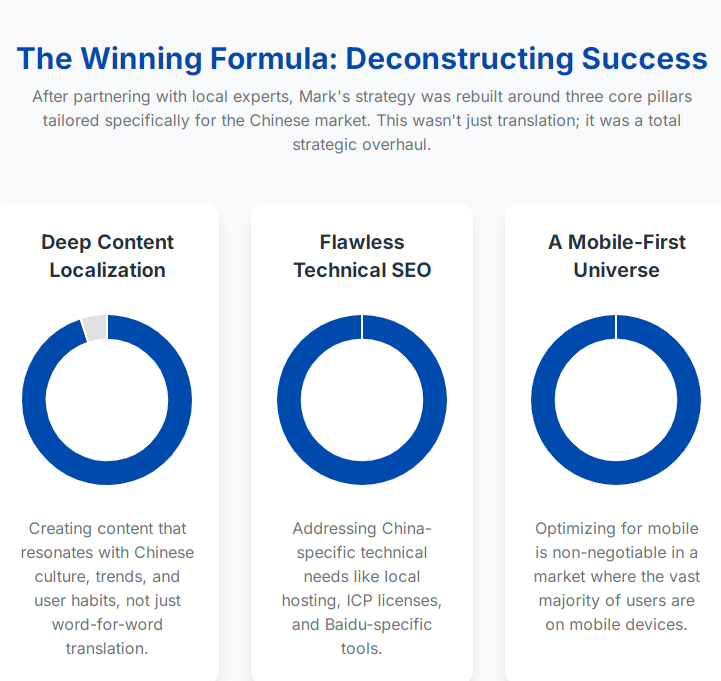China SEO: Not What You Imagine
Have you ever thought that simply replicating Western SEO strategies would work wonders in China?
When we talk to overseas business owners and marketers, we often hear about their confusion regarding the Chinese digital marketing landscape. Many believe that by simply porting their mature Western SEO strategies to China, they can achieve success in the Chinese market. However, the reality is far from it. Today, we will share a true story that reveals the hidden challenges in China’s SEO practices and how Western businesses can truly adapt and win this unique digital marketing battle.
A Western Marketer’s “Lost Journey” in China: When Google Experience Meets the Baidu Great Wall
The protagonist of our story is Mark, the Marketing Director of an international education institution based in London. When the company decided to expand into the Chinese market, Mark’s primary task was to enhance their visibility on Chinese search engines, primarily Baidu. Mark had over a decade of SEO experience in Western markets, having successfully driven significant organic traffic for his company on Google. He was confident that he could replicate this success in China.

Initial Optimism Followed by Confusion and Fear: Mark first led his team to translate the English website content into Chinese and conducted a series of keyword research. They strictly followed the SEO best practices that had proven effective in Western markets: optimizing website structure, building high-quality external links, and publishing a large volume of original content. However, months passed, and the data was disheartening: the website’s Baidu rankings remained stagnant, and traffic showed almost no growth. Mark began to feel confused, even fearful. He worried that this might mean the company’s investment in China would be wasted, and he started to doubt whether his years of accumulated experience were completely ineffective in China.
Conflict and Turning Point: Mark attended a digital marketing summit held in China. During a conversation with a local Chinese SEO expert, he realized the gravity of the problem for the first time. The expert bluntly pointed out that Mark’s team’s strategy was “out of sync” with China. Baidu has its unique algorithms and preferences, which are vastly different from Google’s. Many SEO tactics considered “white hat” in the West might be ineffective or even harmful in Baidu’s eyes. For example, Baidu has higher requirements for content originality and localization, and it holds different views on common Western link-building strategies. Furthermore, a series of unique regulations and technical hurdles, such as China’s internet censorship and ICP filing, left Mark feeling overwhelmed.
Seeking Help and Finding a Way Forward: Mark realized that relying on existing Western experience alone would make it difficult to achieve breakthroughs in the Chinese market. He decided to seek external help and partnered with a local digital marketing company in Shanghai that had extensive experience. This company provided Mark’s team with systematic Baidu SEO training and helped them re-evaluate the website’s current state. They discovered that the previously translated content was too stiff and failed to fully integrate into Chinese local culture and user habits; the website server was located overseas, leading to slow loading speeds, which severely impacted user experience; more importantly, they had overlooked Baidu’s unique considerations for authority in vertical industries and mobile experience.

The Dawn of Success and Lessons Learned: Under the guidance of the local team, Mark readjusted his strategy:
- Content Localization and Local Thinking: They no longer simply translated but collaborated with local Chinese writers to create content that better aligned with Chinese users’ reading habits and cultural background, incorporating more local hot topics and popular phrases.
- Server Optimization and CDN: They migrated the server to mainland China and used a Content Delivery Network (CDN), significantly improving website loading speeds.
- Baidu Algorithm Adaptation: The local team helped them interpret Baidu’s latest algorithms and optimized the website structure and technical SEO, such as the use of Baidu Webmaster Tools and XiongZhangHao integration.
- Mobile-First Approach: Considering that Chinese users primarily access the internet via mobile devices, they thoroughly optimized the website for mobile.
Months later, a miracle happened. The website’s Baidu rankings began to rise steadily, and traffic showed explosive growth. More importantly, by optimizing content and user experience, the website’s conversion rate also significantly improved. Mark finally breathed a sigh of relief, realizing that the success of China SEO was not just a technical issue, but a deep understanding of the market, culture, and regulations.
In-depth Interpretation of Strategies and Activities: The Game Between Chinese and Western SEO
Mark’s experience profoundly reveals the differences between Chinese and Western SEO strategies.
Commendable Aspects:
- Recognizing the Problem and Actively Seeking Professional Help: This was Mark’s wisest decision. When facing an unfamiliar market, seeking help from local experts is key to success.
- Data-Driven Decision Making: Although initial data was not ideal, Mark’s team did not give up. Instead, they identified problems through data analysis and adjusted their strategy accordingly.
- Emphasis on Content Localization: Although initially not done well, later realizing the importance of content localization and improving it became the cornerstone of China SEO success.
Unacceptable Aspects:
- Blindly Copying Western Strategies: The biggest mistake was presumptuously applying Google’s experience to Baidu without fully recognizing the uniqueness of the Chinese market.
- Ignoring Localized Infrastructure: Fundamental issues like server location and ICP filing have a decisive impact on website user experience and search engine rankings in China, yet they were overlooked initially.
- Lack of Understanding of the Chinese Internet Ecosystem: They did not deeply understand Baidu’s algorithms, Baidu’s ecosystem tools (such as Baidu Webmaster Tools, XiongZhangHao), and China’s unique regulatory environment.
Lessons from China SEO for Western Businesses
Mark’s story provides valuable lessons for all Western business owners and marketers hoping to succeed in the Chinese market:
- Localization is King, Not Just Translation: Chinese digital marketing is not just about language translation, but about cultural integration. You need to deeply understand Chinese users’ mindsets, consumption habits, trending topics, and social media preferences. Content needs to align with the local Chinese context to truly resonate.
- Baidu is Not Google; It Requires a Dedicated Strategy: Baidu has its unique algorithms and ranking factors. For example, Baidu places more emphasis on website authority, ICP filing information, server location, and mobile experience. You need to invest time and resources to research Baidu’s characteristics and develop a dedicated SEO strategy for Baidu.
- Technical Compliance and Infrastructure First: Operating a website in China, ICP filing is an indispensable prerequisite. At the same time, setting up servers in mainland China and using CDN services are crucial for ensuring website loading speed and user experience, and are also important considerations for Baidu rankings.
- Partnering with Local Experts is a Shortcut: Facing the complex Chinese market, collaborating with digital marketing companies that have rich local experience can help you avoid detours, adapt to the market faster, and mitigate potential risks. They can provide professional guidance on Baidu algorithms, local culture, and regulatory compliance.
- Patience and Continuous Optimization: The Chinese digital marketing market is dynamic and constantly changing. Algorithms are frequently updated, and user preferences are continuously evolving. Therefore, you need to be patient, continuously monitor data, and constantly adjust and optimize your strategy based on market feedback.
Embracing Chinese Characteristics to Achieve a New Chapter in Digital Marketing
Mark’s story is not an isolated case but a microcosm of the challenges many Western businesses face in the Chinese market. The Chinese digital marketing market is full of opportunities, but it also comes with unique challenges. Success depends not just on technology or capital, but more importantly, on a deep understanding and respect for this land.
In the future, if Western businesses want to succeed in digital marketing in China, they need to shift their mindset. This is not just about search engine optimization, but about how to integrate into a completely new digital ecosystem. This means:
- Building a Localized Team or Collaborating Closely with Local Partners: Ensure you have a team, whether internal or external partners, that understands the Chinese market and culture.
- Actively Embracing China’s Unique Digital Platforms: In addition to Baidu, Chinese-specific platforms like WeChat, Douyin (TikTok), and Xiaohongshu (Little Red Book) have massive user bases and unique marketing opportunities, and they need to be integrated into the overall marketing strategy.
- Focusing on User Experience Localization: Ensure that the design, functionality, and content of websites and applications align with Chinese users’ habits and preferences.
- Continuous Learning and Adaptation: The Chinese digital market changes rapidly. Maintaining keen insight and continuously learning about the latest trends and technologies are key to success.

China SEO is far less simple than you might imagine. It requires you to set aside past experiences and embrace a new challenge with an open mind. Are you ready for this unique digital marketing adventure?

